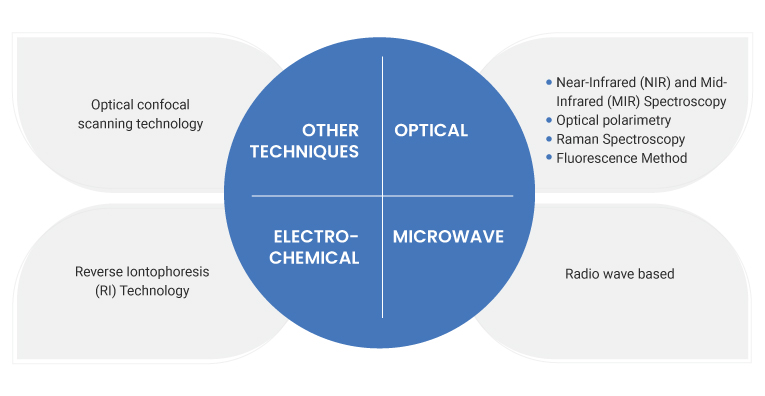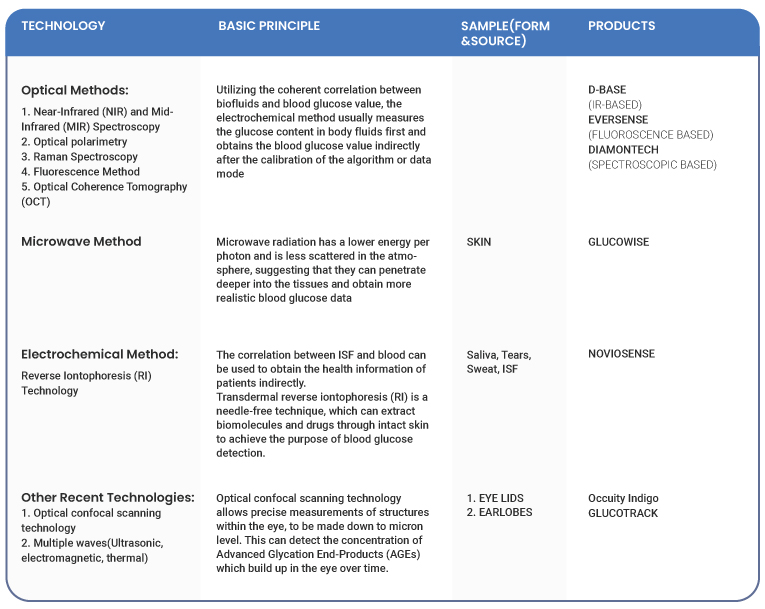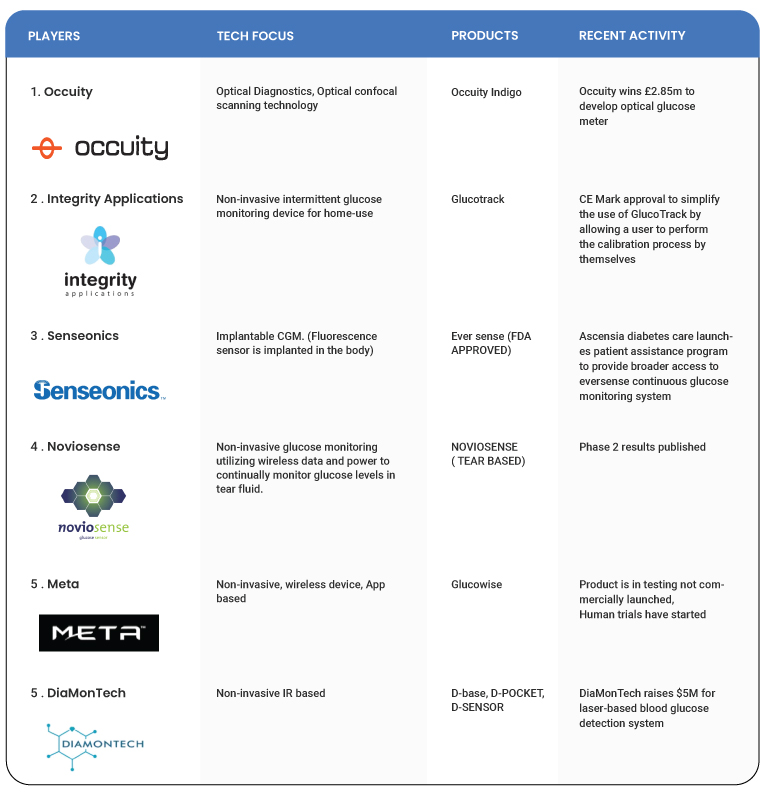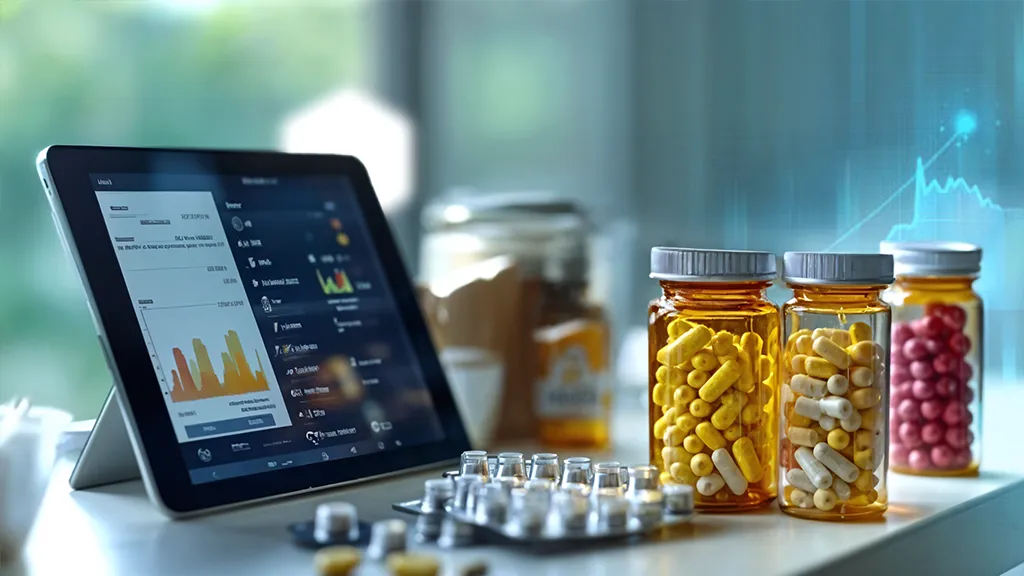The International Diabetic Federation, in its 10th edition 2021, gave quite a shocking revelation that approximately 537 million adults aged 20-79 years are living with diabetes. And about 1 in 2 (240 million) adults live with undiagnosed diabetes. Among the available diagnostic methods hospitals and patients use is to prick their fingers and test in portable POCT/lab devices. The discomfort associated with the gradual punching has paved the way for many non-invasive measures for diagnosing diabetes. However, many questions remain to be answered about their accuracy and sensitivity.
Blood glucose monitoring by non-invasive methods relies on detecting the blood glucose without punching/pricking/piercing the skin and its underlying tissues. There are multiple methods for blood glucose detection non-invasively, divided into the optical, microwave, and electrochemical processes. As shown in the figure below.

Tissue fluids such as saliva, sweat, tears, and Interstitial fluid are handy for glucose estimation. These fluids have been the sample for various electrochemical methods.
Optical methods Utilize the correlation factors, and the correlation value between biofluids and blood glucose is used for calibration. Fluorescence-based monitoring and various methods are dependent on sensors for estimating glucose levels. The classical H2O2 (hydrogen peroxide) is produced by an enzymatic reaction between Gox (glucose oxidase), and a change in fluorescence accompanies glucose. i.e., fluorescence-quenching, the effect of QDs, where QD, i.e., quenching degree, is estimated forms the basis for results. Sensors detect the QD.
Infrared-based detection methods utilize the Infrared wave signals detection from targeted areas (region of interest, based on device, thumb, earlobes). They can predict glucose levels based on calibration models. Similarly, the waves-based approach is used in many wearable products.
Spectroscopy methods mostly use Raman spectroscopy for detection. It’s currently not feasible to adopt the technology in handheld/POCT/wearable devices.

Key Players:

Key Advancements:
Movano has recently announced the completion of its pilot study developing smartwatch-based glucose monitoring wearables. Radio waves-based glucose monitoring is the principal technique behind this advancement. EVYA from the Blue Semi is a 9-sensor-based healthcare gadget with 90 percent accuracy. The global Non-Invasive Glucose Meter market size is currently estimated to gain market growth in the forecast period of 2020 to 2025, pacing with a CAGR of 5.7% in this forecast period, i.e., 2020 to 2025. The market is expected to reach about USD 204.3 million by 2025, from USD 163.4 million in 2019, clocking to a 25% increase.
The non-invasive products usually fall into the wearable and non-wearable categories. The wearable is smartwatch-based sensors like Movano. The Knowlabs Bio-RFID technology(Bio-RFID™) is the latest in the race for non-invasive glucose wearables. An electromagnetic spectrum-based tech (spectroscopy-based) detects unique molecular signatures. The product is on the FDA list for approval and has recently received IRB Approval to initiate the Internal Clinical Trials.
Limitations & Outlook:
The global blood-glucose diabetic market stood at 14.75 billion in 2021, and various marketing pundits estimate it to reach 24 billion by 2026. However, it doesn’t amount to the non-invasive market, which is now pacing up. With the rise in non-invasive platforms, the gap between traditional (invasive) and non-invasive is poised to reduce. However, the non-invasive market is hampered by accuracy and many manufacturing defects. The skin is a big barrier. The pigmentation pattern in skin interferes with infrared. How developers will address this problem is yet to be seen. Below are a few limitations.
Existing Biological Barriers:
- Skin Thickness: The devices relying on electromagnetic fields, i.e., Radio waves & infrared, are poised to be affected by the thickness of the skin. The more thickness, the lesser permeabilization and scattering. Moreover, depending on race, sex, and skin conditions, the variation will increase.
- Sweat-based: The wearable devices relying on sweat for glucose monitoring have certain limitations, primarily environmental conditions. For example, in colder environments or excessive humidity, the sweat output is reduced in the former. In the latter, excessive humidity, impurities, and contamination from salt will hamper the sensor.
However, devices have been launched despite all these limitations, and many are in line for FDA approval. Although invasive methods remain the medical choice for POCT-based and continuous monitoring testing for accuracy and positive medical diagnosis, these non-invasive methods can prove very effective, especially for millions living with undiagnosed and prediabetic conditions.
How Can We Help You?
Ingenious e-Brain is a global provider of research services to the IP team, R&D team, and decision-makers from various verticals marketing, business development, etc. IeB can give detailed technology and IP snapshots in non-invasive glucose monitoring. We can help companies know about developments, key players’ strategic movements, potential targets for acquisition or partnership, white spaces in the domain, players holding strong IP portfolios, and other details. In addition, to this, we can also help in competitive intelligence, product benchmarking, and many more.



